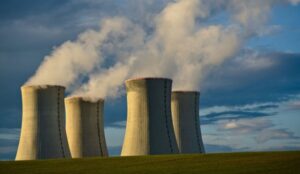 There are two types of radiation. Non-ionizing radiation is the long wavelength portion, and includes microwaves, radio waves, and wavelengths used for cell phones and WiFi. Ionizing radiation includes the short wavelength portion of the electromagnetic spectrum. Both are harmful to your health. This article is about ionizing radiation.
There are two types of radiation. Non-ionizing radiation is the long wavelength portion, and includes microwaves, radio waves, and wavelengths used for cell phones and WiFi. Ionizing radiation includes the short wavelength portion of the electromagnetic spectrum. Both are harmful to your health. This article is about ionizing radiation.
There are several sources of naturally occurring ionizing radiation, including radon gas from the ground, cosmic rays, and radioisotopes in water, rocks and minerals. Other sources include medical tests, such as CT scans and x-rays, and even cigarettes. Nuclear weapons testing, uranium mining, nuclear power waste, and nuclear accidents are the sources people think of most often. The amounts you may be exposed to vary widely, depending on where you live and where you work.
Radioactive particles enter your body through the air, food and water. Once radioactive particles are in your tissues, because of their long half-life they continue to do damage for your entire life. Human cells have repair mechanisms to heal damage from ionizing radiation if exposure is not too high. The dose, duration of exposure, and which body part is exposed factor into the risk.
What Are the Effects of Nuclear Radiation Exposure at Low Levels?
- Cell membrane damage
- Cancer
The Petkau effect
Dr. Aabram Petkau studied the dose of radiation that would rupture a cell membrane. He found that 3500 rads delivered in 2¼ hours would do it. Then he used much weaker radiation and found that 0.7 rads delivered in 11½ hours would also destroy the membrane. This challenged the prevailing assumption of a linear relationship between total dose and the consequences.
This damage to your cell membranes occurs 24/7 nonstop from the radioactive particles inside your body. This amount of damage and repair puts you more at risk for making mistakes, which can lead to cancer. Decades of research show clearly that any dose of radiation increases an individual’s risk for the development of cancer. Children and the elderly are even more at risk.
How do I protect myself?
You can avoid extensive air travel, where you are exposed to cosmic radiation. You can avoid medical procedures that use radiation whenever possible. Avoid cigarette smoking. And be very careful where you choose to live, avoiding nuclear power plants, uranium mines, and military bases that have done weapons testing.
Radioactive particles travel great distances in the atmosphere and come down with dust, rain and snow. Once they come down they stick everywhere.
To know how to protect yourself from environmental exposures, you need to know exactly what you are being exposed to and how much. This information is currently not available in adequate detail. Yes, there is evidence of Iodine 133 and cesium 137. What else exactly? Are some days worse? Are some places worse at certain times? Should there be radiation alert days, much like current air pollution alerts?
How about the food supply? Radioactive particles have been detected in milk products. How about meat? How about vegetables? Are they on the surface, or incorporated into the structure of the plant?
The information needed to make informed decisions is not currently available.
As citizens we need to put pressure onto the government to make monitoring and understanding radiation exposure a priority. And we absolutely need to speak up about wanting energy sources than minimize harm. The risks associated with anything nuclear are significant.
As with many toxic exposures we do not have control over, you need to focus on improving your health and use regular detoxification methods. You can learn more about this by scheduling an appointment with Dr. Veronica and reading additional articles on this blog.
To Your Vibrant Health!
Veronica Tilden, DO
